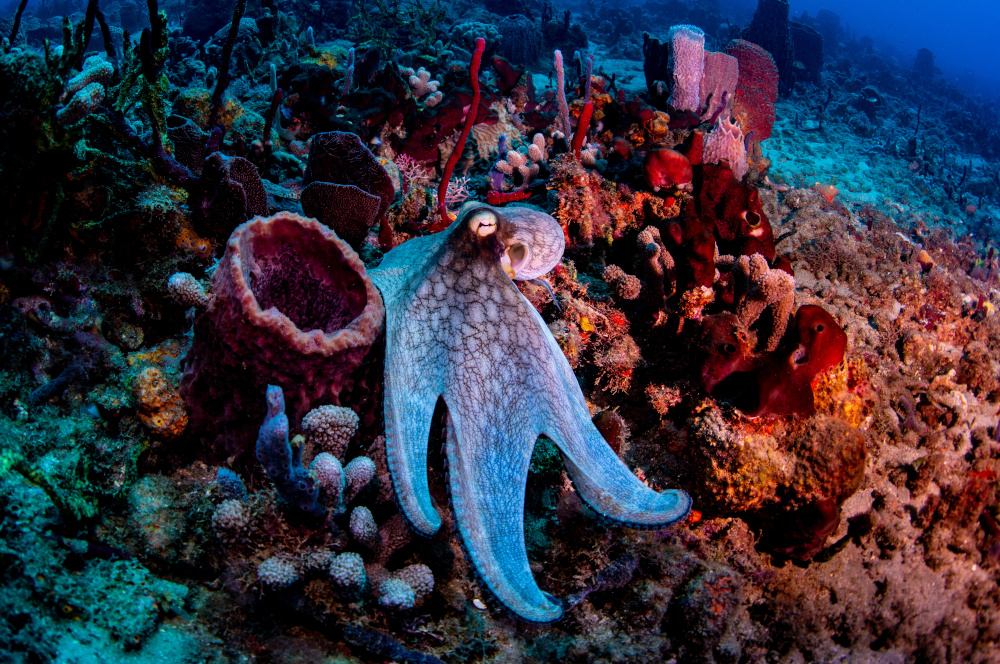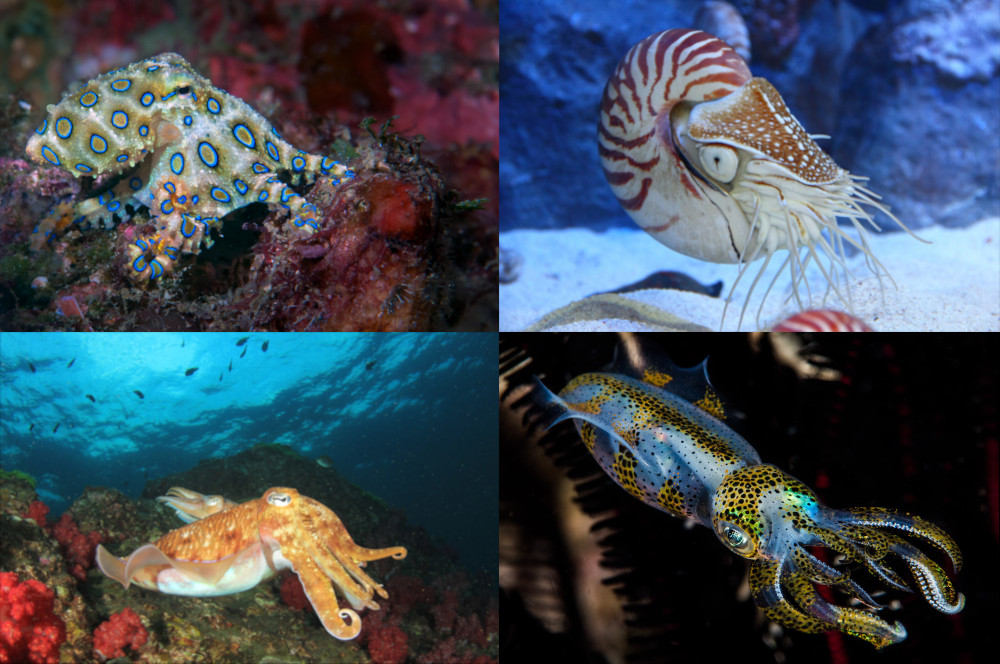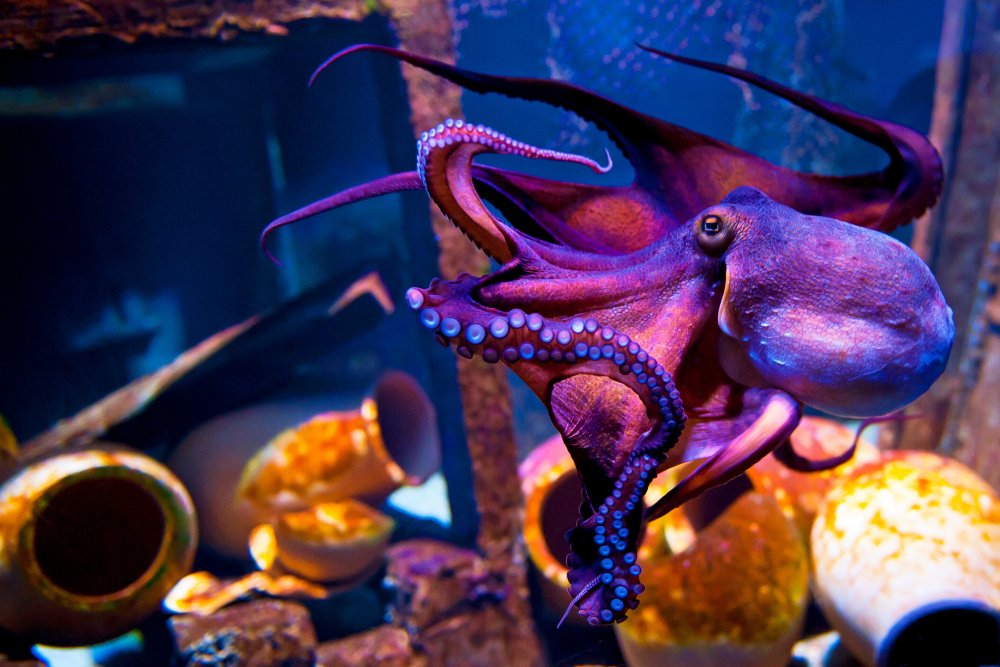Cephalopods in Research
The use of cephalopods in research is a growing field, and the following resources are provided to assist institutions in maintaining good animal welfare when working with these species.
On this page:

Request for Information
OLAW requested input on proposed guidance for use of cephalopods in research, research training, experimentation, or biological testing or for related purposes between September 8, 2023 and December 22, 2023.
The proposed text can be found here: NOT-OD-23-176
The comment period is now closed.
The final text will be published once comments have been considered.
What are Cephalopods?
Cephalopods are a class of invertebrate aquatic animals that includes octopuses, nautiluses, squid, and cuttlefish. These animals belong to the phylum Mollusca, which includes several other invertebrate species such as bivalves and snails. Distinguishing features of cephalopods include a head-like structure, arms and/or tentacles, and a hard beak structure. There are over 800 known species of cephalopods worldwide.
Cephalopods in Research
Cephalopod research has been conducted for over 100 years. These studies have provided valuable insight into the science of learning, motion and movement, behavior, and nervous system development. Recent initiatives to formalize standards for cephalopod care and use are helping to ensure continued humane treatment and honor the principles of the 3Rs: Replacement, Reduction, and Refinement.

Quick References
OLAW provides these resources as a courtesy and any questions regarding the content should be addressed to the authors. OLAW is providing them for informational value and not as regulatory guidance. The information in each article does not necessarily represent the views of the NIH.
Please email suggested resources to the Division of Policy and Education. Commercial entities are not eligible for listing.

Useful External Guidelines
The following list provides a limited collection of guidelines for the care and use of cephalopods authored by various institutions and professional associations worldwide. While not considered official guidance for Assured Institutions by OLAW, the information presented in these references may be useful in designing high-quality programs that ensure good animal welfare.

Databases and Organizations
The following additional links provide the names of databases and professional organizations that promote responsible use of cephalopods in research:
- NORECOPA: Cephalopods in research database
- CephsInAction
- Association for Cephalopod Research "CephRes" (Training materials available under "training resources")

Compliance Unit Standard Procedure (CUSP) Sharing Site
The Compliance Unit Standard Procedure (CUSP) Sharing Site is an online repository where participating institutions can share standard procedures used in animal care protocols, supporting the development of high-quality protocols, while reducing burden for researchers, IACUCs, and IACUC support staff. The goal is to assist institutions to easily build a library of standard procedures to use for multiple purposes, such as variations on commonly used techniques, practical information for non-typical species, and methodology used in wildlife studies. Access will initially be limited to FDP (Federal Demonstration Partnership) member institutions (includes ~200 institutions), but the site will ultimately be available to all institutions.
Laws, Policies, and Guidance
Laws and Policies
Though cephalopods are not covered under the PHS Policy on Humane Care and Use of Laboratory Animals (PHS Policy), institutions are expected to adhere to the U.S. Government Principles for the Utilization and Care of Vertebrate Animals Used in Testing, Research, and Training for humane care and use of all animals in their care. In addition, because cephalopods are not vertebrate animals, they are not currently subject to the requirements for reporting and there is no requirement to submit a Vertebrate Animals Section for cephalopod use in funding applications.
Guidance
| NOT-OD-23-176 | Request for Information (RFI) on Proposed Guidance to Assured Institutions on Cephalopod Care and Use | September 7, 2023 |
| NOT-OD-23-057 | NIH Encourages the Use of the ARRIVE Essential 10 Checklist in all Publications Reporting on the Results of Vertebrate Animal and Cephalopod Research | February 10, 2023 |

Pain Perception, Neurobiology, Cognition, and Learning
OLAW provides these articles as a courtesy and any questions regarding the content should be addressed to the authors. OLAW is providing them for informational value and not as regulatory guidance. The information in each article does not necessarily represent the views of the National Institutes of Health (NIH).
Please email suggested resources to the Division of Policy and Education.
- Burrell, Brian D. 2017. “Comparative Biology of Pain: What Invertebrates Can Tell Us about How Nociception Works.” Journal of Neurophysiology 117 (4): 1461–73.
- Crook, Robyn J. et al. 2013. “Squid Have Nociceptors That Display Widespread Long-Term Sensitization and Spontaneous Activity after Bodily Injury.” Journal of Neuroscience 33 (24): 10021–26.
- Hague, Theresa et al. 2013. “Preliminary in Vitro Functional Evidence for Reflex Responses to Noxious Stimuli in the Arms of Octopus Vulgaris.” J. Exp. Mar. Bio. Ecol. 447: 100–105.
- Walters, Edgar T. 2018. “Nociceptive Biology of Molluscs and Arthropods: Evolutionary Clues about Functions and Mechanisms Potentially Related to Pain.” Frontiers in Physiology 9: 1049.
- Agin, Véronique, et al. 2006. "The “prawn-in-the-tube” procedure in the cuttlefish: Habituation or passive avoidance learning?" Learning & Memory 13(1): 97-101.
- Amodio, Piero et al. 2019. “Grow Smart and Die Young: Why Did Cephalopods Evolve Intelligence?” Trends in Ecology and Evolution 34 (1): 45–56.
- Bellanger, Cécile et al. 2003. “Changes in Cholinergic Enzyme Activities in the Cuttlefish Brain during Memory Formation.” Physiology and Behavior 79 (4–5): 749–56.
- Boal, J. G. et al. 2000. “Observational Learning Does Not Explain Improvement in Predation Tactics by Cuttlefish (Mollusca: Cephalopoda.” Behavioural Processes 52 (2–3): 141–53.
- Crook, Robyn J. et al. 2009. “Memory of Visual and Topographical Features Suggests Spatial Learning in Nautilus (Nautilus Pompilius L.).” Journal of Comparative Psychology 123 (3): 264–74.
- Darmaillacq, Anne-Sophie et al. 2004. “Rapid Taste Aversion Learning in Adult Cuttlefish, Sepia Officinalis.” Animal Behaviour 68 (6): 1291–98.
- Darmaillacq, Anne-Sophie et al. 2008. “Embryonic Visual Learning in the Cuttlefish, Sepia Officinalis.” Animal Behaviour 76 (1): 131–34.
- Dickel, Ludovic et al. 2001. “Increase of Learning Abilities and Maturation of the Vertical Lobe Complex during Postembryonic Development in the Cuttlefish, Sepia.” Developmental Psychobiology 39 (2): 92–98.
- Di Poi, Carole et al. 2013. “Effects of Perinatal Exposure to Waterborne Fluoxetine on Memory Processing in the Cuttlefish Sepia Officinalis” Aquatic Toxicology 132: 84–91.
- Di Poi, Carole et al. 2014. “Cryptic and Biochemical Responses of Young Cuttlefish Sepia Officinalis Exposed to Environmentally Relevant Concentrations of Fluoxetine.” Aquatic Toxicology 151: 36–45.
- Fiorito, Graziano et al. 1990. “Problem Solving Ability of Octopus Vulgaris Lamarck (Mollusca, Cephalopoda.” Behavioral and Neural Biology 53 (2): 217–30.
- Fiorito, Graziano And Raymond Chichery. 1995. “Lesions of the Vertical Lobe Impair Visual Discrimination Learning by Observation in Octopus Vulgaris.” Neuroscience Letters 192 (2): 117–20.
- Grasso, Frank W. And Jennifer A. Basil. 2009. “The Evolution of Flexible Behavioral Repertoires in Cephalopod Molluscs.” Brain, Behavior, and Evolution 74 (3): 231–45.
- Gutnick, Tamar et al. 2022. “Neuroecology: Forces That Shape the Octopus Brain.” Current Biology 32 (3): R131–35.
- Huang, Kuan-Ling And Chuan-Chin Chiao. 2013. “Can Cuttlefish Learn by Observing Others?” Animal Cognition 16 (3): 313–20.
- Huffard, Christine L. 2013. “Cephalopod Neurobiology: An Introduction for Biologists Working in Other Model Systems.” Invertebrate Neuroscience 13 (1): 11–18.
- Hvorecny, Lauren M. et al. 2007. “Octopuses (Octopus Bimaculoides) and Cuttlefishes (Sepia Pharaonis, S. Officinalis) Can Conditionally Discriminate.” Animal Cognition 10 (4): 449–59.
- Mather, Jennifer A. 2008. “Cephalopod Consciousness: Behavioural Evidence.” Consciousness and Cognition 17 (1): 37–48.
- Mather, Jennifer A. and Ludovic Dickel. 2017. “Cephalopod Complex Cognition.” Current Opinion in Behavioral Sciences 16: 131–37.
- Messenger, J.B. 1973. “Learning in the Cuttlefish, Sepia.” Animal Behaviour 21 (4): 801–26.
- Perez, Paul V. et al. 2017. “The Selective Serotonin Reuptake Inhibitor Fluoxetine Increases Spontaneous Afferent Firing, but Not Mechanonociceptive Sensitization, in Octopus.” Invertebrate Neuroscience 17 (4): 10.
- Shigeno, Shuichi et al. 2018. “Cephalopod Brains: An Overview of Current Knowledge to Facilitate Comparison with Vertebrates.” Frontiers in Physiology 9: 952.
- Shomrat, Tal et al. 2008. “The Octopus Vertical Lobe Modulates Short-Term Learning Rate and Uses LTP to Acquire Long-Term Memory.” Current Biology 18 (5): 337–42.
- Shomrat, Tal et al. 2010. “Serotonin Is a Facilitatory Neuromodulator of Synaptic Transmission and ‘Reinforces’ Long-Term Potentiation Induction in the Vertical Lobe of Octopus Vulgaris.” Neuroscience 169 (1): 52–64.
- Shomrat, Tal et al. 2015. “The Vertical Lobe of Cephalopods: An Attractive Brain Structure for Understanding the Evolution of Advanced Learning and Memory Systems.” Journal of Comparative Physiology 201 (9): 947–56.
- Wells, M.J. and J.Z. Young. 1966. “Lateral Interaction and Transfer in the Tactile Memory of the Octopus.” Journal of Experimental Biology 45 (3): 383–400.
- Wells, M.J. and J.Z. Young. 1969. “The Effect of Splitting Part of the Brain or Removal of the Median Inferior Frontal Lobe on Touch Learning in Octopus.” Journal of Experimental Biology 50 (2): 515–26.
- Wells, M.J. and J.Z. Young. 1970. “Single-Session Learning by Octopuses.” Journal of Experimental Biology 53 (3): 779–88.
- Wells, M.J. and J.Z. Young. 1972. “The Median Inferior Frontal Lobe and Touch Learning in the Octopus.” Journal of Experimental Biology 56 (2): 381–402.
- Wells, M.J. and J.Z. Young. 1975. “The Subfrontal Lobe and Touch Learning in the Octopus.” Brain Research 92 (1): 103–21.
- Yasumuro, Haruhiko, and Yuzuru Ikeda. 2018. “Environmental Enrichment Affects the Ontogeny of Learning, Memory, and Depth Perception of the Pharaoh Cuttlefish Sepia Pharaonis.” Zoology 128: 27–37.
- Alupay, Jean S. et al. 2014. “Arm Injury Produces Long-Term Behavioral and Neural Hypersensitivity in Octopus.” Neuroscience Letters 558: 137–42.
- Crook, Robyn J. 2021. “Behavioral and Neurophysiological Evidence Suggests Affective Pain Experience in Octopus.” iScience 24 (3): 102229.
- Crook, Robyn J., et al. 2011. “Peripheral Injury Induces Long-Term Sensitization of Defensive Responses to Visual and Tactile Stimuli in the Squid Loligo Pealeii, Lesueur 1821.” Journal of Experimental Biology 214 (19): 3173–85
- Crook, Robyn J. et al. 2014. “Nociceptive Sensitization Reduces Predation Risk.” Current Biology 24 (10): 1121–25.
- Messenger, J.B. 1971. “Two-Stage Recovery of a Response in Sepia.” Nature 232 (5307): 202–3.
Cephalopod Medicine and Welfare
OLAW provides these resources as a courtesy and any questions regarding the content should be addressed to the authors. OLAW is providing them for informational value and not as regulatory guidance. The information in each article does not necessarily represent the views of the NIH.
Please email suggested resources to the Division of Policy and Education.
- De Sio, Fabio et al. 2020. "E Pluribus Octo–building consensus on standards of care and experimentation in cephalopod research; a historical outlook." Frontiers in physiology 11: 645.
- Fiorito, Graziano et al. 2015. “Guidelines for the Care and Welfare of Cephalopods in Research–A Consensus Based on an Initiative by CephRes, FELASA and the Boyd Group.” Laboratory Animals 49 (2) Supplement: 1–90.
- National Research Council. 2011. “Spineless Wonders: Welfare and Use of Invertebrates in the Laboratory and Classroom.” ILAR Journal 52 (2): 121–220.
- Ponte, Giovanna et al. 2023. "General and species-specific recommendations for minimal requirements for the use of cephalopods in scientific research." Laboratory Animals 57.1: 26-39.
- Scimeca, Joseph M., Gregory J. Barord, and Gregory A. Lewbart. 2022. “Chapter 9: Cephalopods.”Invertebrate Medicine, 3rd Ed., edited by Gregory A. Lewbart, 177–202. Hoboken, NJ: Wiley-Blackwell.
- Crook, Robyn J. 2013. “The Welfare of Invertebrate Animals in Research: Can Science’s next Generation Improve Their Lot.” PostDoc Journal 1 (2): 9–20.
- Drinkwater, Eleanor, Elva JH Robinson, and Adam G. Hart. 2019. “Keeping Invertebrate Research Ethical in a Landscape of Shifting Public Opinion.” Methods in Ecology and Evolution 10 (8): 1265–73.
- Fiorito, Graziano et al. 2014. “Cephalopods in Neuroscience: Regulations, Research and the 3Rs.” Invertebrate Neuroscience 14: 13–36.
- Harvey-Clark, Chris. 2011. “IACUC Challenges in Invertebrate Research.” ILAR Jour 52 (2): 213–20.
- Moltschaniwskyj, N.A. et al. 2007. “Ethical and Welfare Considerations When Using Cephalopods as Experimental Animals.” Rev Fish Biol Fisheries 17: 455–76.
- Smith, Jane A. et al. 2013. "Cephalopod Research and EU Directive 2010/63/EU: Requirements, Impacts and Ethical Review." Journal of Experimental Marine Biology and Ecology 447: 31-45.
- Abbo, Lisa A. et al. 2021. “Anesthetic Efficacy of Magnesium Chloride and Ethyl Alcohol in Temperate Octopus and Cuttlefish Species.” JAALAS 60 (5): 556–67.
- Andrews, Paul L.R. et al. 2013. “The Identification and Management of Pain, Suffering and Distress in Cephalopods, Including Anaesthesia, Analgesia and Humane Killing.” J. Exp. Mar. Bio. Ecol. 447: 46-64.
- Butler-Struben, Hanna M. etal. 2018. “In Vivo Recording of Neural and Behavioral Correlates of Anesthesia Induction, Reversal, and Euthanasia in Cephalopod Molluscs.” Frontiers in Physiology 20 (109)
- Cooper, John E. 2011. “Anesthesia, Analgesia, and Euthanasia of Invertebrates.” ILAR Journal 52 (2): 196–204.
- Gleadall, Ian G. 2013. “The Effects of Prospective Anaesthetic Substances on Cephalopods: Summary of Original Data and a Brief Review of Studies over the Last Two Decades.” J. Exp. Mar. Bio. Ecol. 447: 23–30.
- Gonçalves, Rui A. et al. 2012. “The Use of Different Anaesthetics as Welfare Promoters during Short-Term Human Manipulation of European Cuttlefish (Sepia Officinalis) Juveniles.” Aquaculture 370: 130–35.
- Polese, Gianluca et al. 2014. “Dose-Dependent Effects of the Clinical Anesthetic Isoflurane on Octopus Vulgaris: A Contribution to Cephalopod Welfare.” Journal of Aquatic Animal Health 26 (4): 285–94.
- Winlow, William et al. 2018. “Sense and Insensibility–An Appraisal of the Effects of Clinical Anesthetics on Gastropod and Cephalopod Molluscs as a Step to Improved Welfare of Cephalopods.” Frontiers in Physiology 9 (1147).
- Chancellor, Stephanie, Lisa Abbo, Bret Grasse, Taylor Sakmar, Joel S. Brown, David Scheel, and Rachel M. Santymire. 2021. “Determining the Effectiveness of Using Dermal Swabs to Evaluate the Stress Physiology of Laboratory Cephalopods: A Preliminary Investigation.” General and Comparative Endocrinology 314:113903
- Gore, S.R. et al. 2005. “Enrofloxacin Pharmacokinetics in the European Cuttlefish, Sepia Officinalis, after a Single Iv Injection and Bath Administration.” J. Vet. Pharmacol. Ther. 28 (5): 433–39.
- Holst, Meghan M., and Tim Miller-Morgan. 2021. “The Use of a Species-Specific Health and Welfare Assessment Tool for the Giant Pacific Octopus, Enteroctopus Dofleini.” JAAWS 24 (3): 272–91.
- Jerez-Cepa I. and Ignacio Ruiz-Jarabo. 2021. “Physiology: An Important Tool to Assess the Welfare of Aquatic Animals.” Biology 10 (1): 61.
- Lopes, Vanessa M. et al. 2017. “Cephalopod Biology and Care, a COST FA1301 (CephsInAction) Training School: Anaesthesia and Scientific Procedures.” Invertebrate Neuro 17 (3): 8.
- Narshi, Tanya M. et al. 2022. “Welfare Assessment of Invertebrates: Adapting the Animal Welfare Assessment Grid (AWAG) for Zoo Decapods and Cephalopods.” Animals 12 (13): 1675.
- Petrić, Mirela et al. 2018. "Procedure of hemolymph sampling in Octopus vulgaris." 3rd Congress of Croatian Laboratory Animal Science Association (CroLASA) and 2nd joint Congress of CroLASA and Society for Laboratory Animals of Slovenia (SLAS) with international participation.
- Sykes, António V. and Camino Gestal. 2014. “Welfare and Diseases under Culture Conditions.” Cephalopod Culture, 97–112. Dordecht: Springer.
- Sykes, António V. et al. 2017. “The Digestive Tract of Cephalopods: A Neglected Topic of Relevance to Animal Welfare in the Laboratory and Aquaculture.” Frontiers in Physiology 8: 492.








